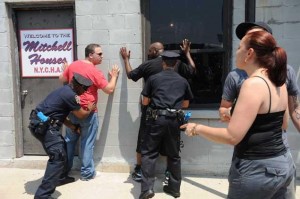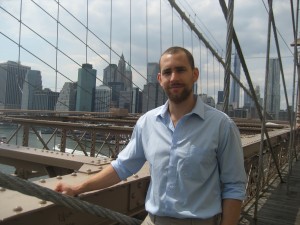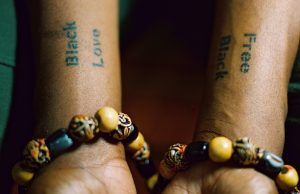Stop and Frisk: Violence Subsidies and the Myth of Order
By Roberto E. Alejandro
In a scene from 1952’s High Noon, Gary Cooper’s Marshal Kane enters the town parish in the hopes of recruiting deputies to help him fend off the soon-to-arrive “bad guy” Frank Miller. The scene begins with a long shot of the church, Kane, his back to the camera, walking towards it.
The Western has, for a long time, held a place of prominence in the American imagination. The hero, usually some sort of gun-fighter, enters a community beset by violence and exacts some gun-based form of justice against bad guys, restoring the rule of law. It is an appealing storyline. It is also a fundamental misinterpretation of the Western.
Kane’s solitary walk to the church, where much of the town is gathered, is an expression of his standing, at all times, outside the community. This is not because, as representative of the law, he must stand apart from the community governed by it, embodying the impartiality of law. Rather, Kane exists outside of the community because he represents violence, that which has no place in civil society and yet is the very basis of civil order.
Inside the church, the parson is beginning his sermon, reading the first verse of Malachi 4. “For behold, the day cometh that you’ll burn as an oven, and all the proud, yea, and all that do wickedly shall be as . . .”
The reading is interrupted by Kane’s entrance into the sanctuary. “I’m sorry parson, I don’t want to disturb the services.”
“You already have,” replies the parson.
The parson’s text is an expression of a particular view of justice, one that transcends individual agency and yet operates to preserve order. Kane’s appearance, both literally and figuratively, disrupts this narrative. Justice and order are not products of some transcendent sense of right action operating in the universe, but of the gun he displays prominently in this house of worship. Kane’s very presence, his disruption of this narrative, is unwanted. Both he and the parsons appear acutely aware of this.
Kane asks for volunteer deputies, initially receiving a positive response before one congregant stands up and suggests that rather than a civil matter, this is a personal matter between Kane and Miller. The town mayor stands and demands that the issue be discussed “like grown up people,” and asks that the children go outside.
The children stream out of the church, excited to play rather than sit through the parson’s sermon, and into the very calm that will now be discussed inside the sanctuary. A calm that was established by the gun hand of Marshal Kane, “the best marshal we ever had” in the mayor’s estimation.
After some discussion among the townspeople, the mayor asks for the parson’s opinion.
“I don’t know,” replies the parson. “The commandments say ‘thou shalt not kill’, but we hire men to go out and do it for us. The right and the wrong seem pretty clear here. But if you’re asking me to tell my people to go out and kill, and maybe get themselves killed, I’m sorry. I don’t know what to say. I’m sorry.”
Herein lies the basic tension that is the drama of so many Westerns. Civil order and society, premised on “thou shalt not kill” among other assumptions concerning civility, are made possible by those who do violence in our stead. That is, the non-violence and “safety” of civil order is subsidized by those willing to engage in the very sort of acts that must stand outside civil society, and who, in so doing, agree—advertently or not—to forever stand outside the community.
By the end of the scene, no one has volunteered. The mayor now claims that any violence in the town will be a function of Kane’s continued presence and asks Kane to leave. The mayor’s claim is an assertion of the myth that violence, far from systemic, is in all actuality something purely engaged in at the individual level and possible of bearing only individual fault.
It is the very myth the lawman gives life to in effecting violence against “criminals” like Miller, a man with no narrative that might shed light on his decisions, perspectives, or actions. Miller is simply a bad individual. There is no room in the community’s understanding of Miller for the suggestion that a term like bad must exist within a context in which certain valuations have been made, allowing terms like good or bad to come to bear, a process of valuation that both informs the boundaries of that system the community terms social order and that may very well have had no room for Miller’s participation. Miller has no story. He is simply bad.
Kane never succeeds in recruiting deputies and is left to face Miller and his men alone. After disposing of them, the films ends with Kane leaving the town with his new bride. Kane, whose name alludes to the Bible’s first murderer, self-exiles from the community, having fully realized the externality that his willingness to effect violence has wrought.
In the United States, we often speak colloquially of “the effects of the law,” as though the law has some agency of its own. But law, and order for that matter, have no agency and therefore no effect. Rather, both law and order are effected by violence, a violence done in our name. The “hero” of the Western has to be exiled because he is at all times an unwelcome reminder of this fact.
But those who do violence in our stead and stand forever outside the community are not only the hired guns. In all American cities there are “safe” neighborhoods and “bad” neighborhoods, just as the stability of suburbs may be contrasted to the violence of what is often referred to as the inner city.
Violence is more common, or thought to be so, in these “bad” neighborhoods. But much as the non-violence of citizens is subsidized by the violence of law enforcers, the relative non-violence of “safe” neighborhoods is subsidized by the violence of “bad” neighborhoods. Hence the heavy police presence, a presence that serves not to reduce violence but to contain it.
Life in a town or neighborhood with safe streets, good schools, and myriad economic resources is subsidized by the violence, lack of functioning institutions, and lack of economic resources in those “bad” neighborhoods. These neighborhoods take on not only the deprivation of this arrangement, but the community service of acting violently. Through violence, those who find themselves living in these “bad” neighborhoods not only set themselves outside the very community they make possible, but they do us the favor of reinforcing our myth of individual responsibility that allows us to refer to these neighborhoods simply as “bad.”
This is why one speaks of the inner city, the way one speaks of the soul as the inner man. That unsafe, violent part of the city is the true site of civil order. There is no Upper West Side without projects and burning boroughs.
 The New York City Council recently passed two bills with veto-proof majorities, over the objections of both Mayor Michael Bloomberg and Police Commissioner Raymond Kelly, intended to rein in the New York Police Department’s practice of stop-and-frisk. The basis of the mayor and commissioner’s objection, however, is not that stop-and-frisk is an effective law enforcement tool, but an effective means of maintaining the invisibility of civil society’s violence subsidy.
The New York City Council recently passed two bills with veto-proof majorities, over the objections of both Mayor Michael Bloomberg and Police Commissioner Raymond Kelly, intended to rein in the New York Police Department’s practice of stop-and-frisk. The basis of the mayor and commissioner’s objection, however, is not that stop-and-frisk is an effective law enforcement tool, but an effective means of maintaining the invisibility of civil society’s violence subsidy.
However, the New York once inherited by former Mayor Rudolph Giuliani no longer exists, and now the very policies that made invisible New York’s violence subsidy appears unpalatable to the congregants worshiping transcendent notions of justice and law inside the sanctuary of civil order. Bloomberg and Kelly have simply failed to reached Kane’s realization: that they are no longer wanted, no longer seen as necessary; that it is time for their exile. Striking, considering it was not that long ago that term limit rules were altered so that Bloomberg could remain in office (the best mayor we ever had?).
Bloomberg and Kelly may now be sacrificed precisely because it is unlikely that a change in the stop-and-frisk policy will return New York to that city inherited by Giuliani. The violence of the police regime that descended upon this city in Giuliani’s wake was effective. But it must not be lost on us that the grounds of their exile, that sense of order and safety so cherished by our bourgeois sensibilities, is the real act of violence, premised on a deprivation of resources and a caging in of a desperation that results in eruptions of violence.
Stop and frisk is hardly a new policy, but only recently has it become an issue for the upper (middle-) class, largely white, and largely left-leaning New Yorkers that make up New York’s community—those who policy-makers seek to appease, who continue to enjoy the fruit which stop and frisk has harvested, whose “safety” was the premise of stop and frisk to begin with, and a group to which I certainly belong. We oppose policies like stop-and-frisk not because we are good, and liberal, and because it appalls us; but because our violence has been so complete, so effectively enacted by our hired guns and inner city exiles, that we no longer need tolerate any reminders of our guilt.
________________________________________
 Roberto E. Alejandro is a freelance writer and essayist living in New York City.
Roberto E. Alejandro is a freelance writer and essayist living in New York City.




Pingback: The Role of the Constitution in Social Order | The Ecce Homo Project